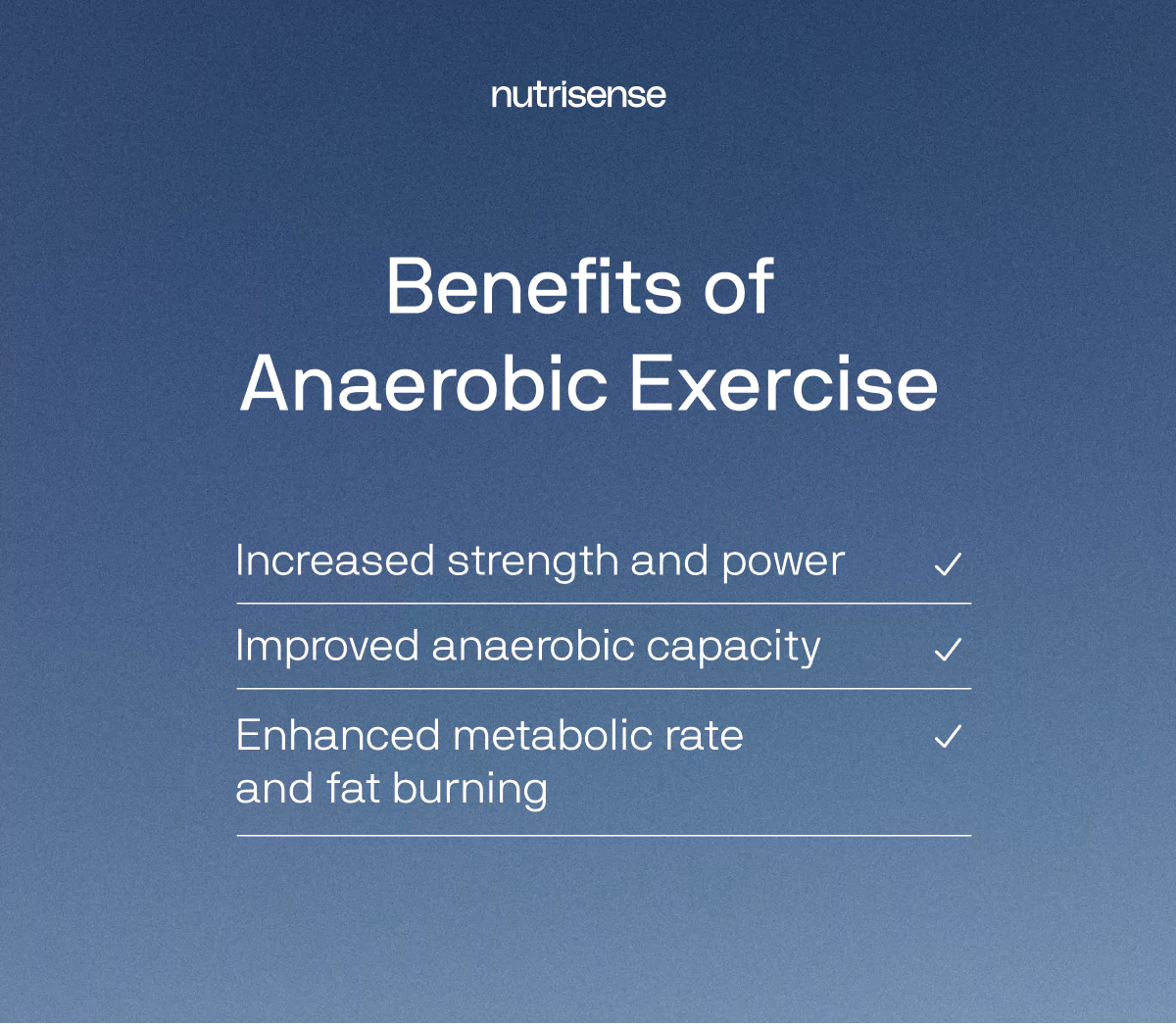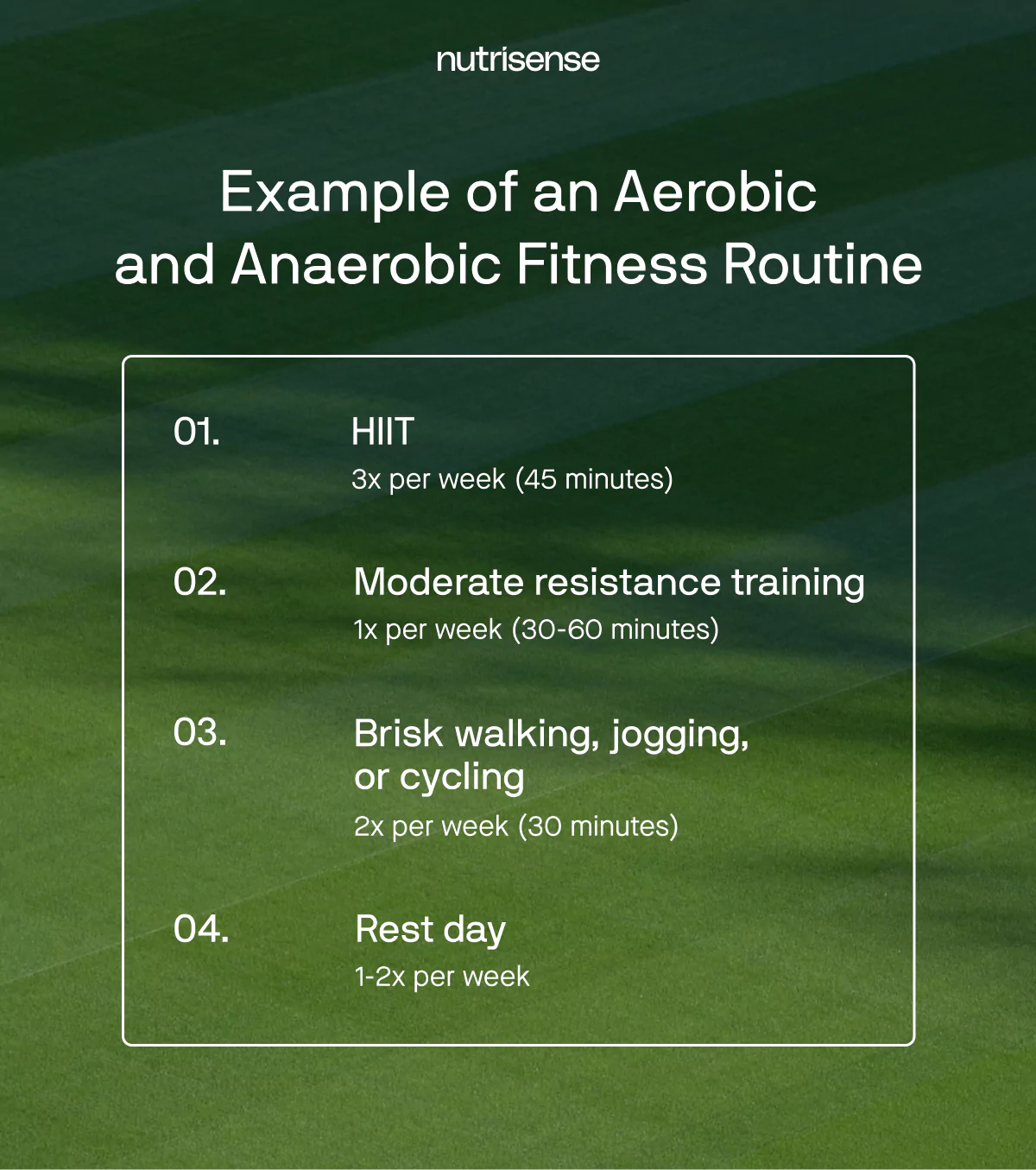What is Anaerobic Exercise?

Key Takeways
Whether you're a seasoned fitness enthusiast or just starting on your path to a healthier lifestyle, a well-rounded routine with a combination of different types of exercise can keep you engaged, improve your workout performance, and benefit your overall health.
One type of exercise to consider incorporating into your routine is anaerobic exercise. While aerobic exercise, like running or swimming, focuses on endurance and cardiovascular health, anaerobic exercise takes a different approach, emphasizing short bursts of more intense activity.
In this article, we will dive into the world of anaerobic exercise, understanding what it is and its significance for your health.
Characteristics of Anaerobic Exercise

Anaerobic exercise involves short bursts of high-intensity effort, typically ranging from a few seconds up to around two minutes. As opposed to aerobic exercise, the term anaerobic means that the body does not rely on oxygen for producing energy.
This is because anaerobic exercise requires energy faster than your body’s oxygen stores can supply. Since your body cannot deliver oxygen fast enough, it has to rely on alternate energy systems involving anaerobic metabolism, including a process called anaerobic glycolysis.
Glycolysis is the process by which glucose is broken down to form pyruvate and eventually, adenosine triphosphate (ATP), a source of stored energy in the body. Depending on whether sufficient oxygen is available, pyruvate may have different fates. Under anaerobic conditions, pyruvate is converted to lactate.
Anaerobic exercise can lead to the buildup of lactic acid in the muscles, which assists with glucose production and cell respiration within the muscle cells.
Aerobic vs. Anaerobic Exercise

- Distance running, cycling, swimming
- Anaerobic - Shorter, more intense bursts of activity focused on building strength and power
- Sprints
- Interval training
- Weight Lifting
Aerobic exercises are typically moderate-intensity activities that use large muscle groups and can be sustained for an extended period. Aerobic exercises rely on oxygen to produce energy and support cardiovascular health, endurance, and may even help reduce the risk of many chronic diseases.
Examples of cardio, or aerobic training include:
- Distance running
- Brisk walking
- Swimming
- Jumping rope
- Cycling
Of course, some of these exercises can contain a blend of aerobic and anaerobic exercise to varying degrees.
Anaerobic activities, on the other hand, are shorter, more intense bursts of activity focused on building strength and power, building muscle, and enhancing athletic performance. Examples of anaerobic exercise include:
- Sprints
- Strength training
- Interval training
- Plyometric exercises
Alternating between aerobic and anaerobic exercises can prevent fitness plateaus and keep your body well-conditioned.
Common Types of Anaerobic Exercise

Some of the most common types of anaerobic exercise include HIIT, weight lifting, sprints, and other explosive movements. Let’s look at the functions of each one:
High-Intensity Interval Training (HIIT)
High-intensity interval training, or HIIT, is a popular form of anaerobic training that involves alternating between short bursts of intense activity and periods of rest or lower-intensity activity. The workout typically consists of short intervals of all-out effort, followed by brief recovery periods.
Research has found that high-intensity exercise can maximize positive health outcomes, benefit cardiovascular and metabolic health, support weight management and fat loss, and may even reduce the severity of depression.
Weight Lifting and Resistance Training
Weight lifting and resistance training are a type of anaerobic exercise that focuses on building strength, power, and muscle mass. They involve lifting weights or working against resistance, which challenges the muscles to generate force in short bursts of high-intensity effort.
Building strength, muscle mass, and power through anaerobic exercise offers many benefits for overall physical performance and well-being. Increased strength can improve body composition and make it easier to complete daily functional activities and reduce the risk of injuries.
Gaining muscle mass also boosts metabolic rate, promoting weight management. Weight training has also been shown to increase bone mass and density, aiding in the management of conditions like osteoporosis. Insulin sensitivity and glucose tolerance may also be improved by the addition of lean muscle mass and resistance training.
Sprinting and Explosive Movements

Sprinting and explosive movements are included in this list because of their short duration and high intensity. Both activities demand rapid bursts of effort, pushing the body to perform at or near its maximum capacity.
Research shows that sprint interval training can improve overall athletic performance; increase strength, power, and endurance; and may reduce the risk of chronic illnesses associated with a sedentary lifestyle. Studies have also found that explosive movement exercises, also called plyometrics, can help to:
- Increase muscle mass
- Aid in fat loss
- Improve speed and agility in athletic performance
3 Benefits of Anaerobic Exercise

Incorporating these high-intensity anaerobic exercises into your workout routine has several health benefits. Here are the three key benefits of anaerobic exercise:
1) Increased Strength and Power
As we’ve already explored, anaerobic exercises have been shown to benefit muscle strength and power. Plyometric exercises also enhance explosive power, benefiting you as an athlete by improving speed and force production.
This can allow you to excel in activities that require quick, powerful movements. Additionally, increased muscular strength contributes to better stability, balance, and injury prevention.
2) Improved Anaerobic Capacity
Regular anaerobic exercise builds endurance and anaerobic capacity, which can improve your performance in exercises that rely heavily on short bursts of intense effort, such as sprinting and weight lifting. With this training, it can become easier to generate more power, maintain speed, and lift heavier weights without succumbing to fatigue.
3) Enhanced Metabolic Rate and Fat Burning
The post-exercise calorie burn associated with anaerobic workouts is a significant benefit known as excess post-exercise oxygen consumption (EPOC) or the "afterburn effect." After intense anaerobic exercise, the body continues to consume oxygen at a high rate to restore energy and repair tissues.
This increased oxygen consumption results in continued calorie burn even after the workout is complete. The combination of increased muscle mass from anaerobic workouts, elevated metabolic rate, and the additional calories burned during the post-exercise recovery period helps you achieve a more efficient fat-burning state.
Is Anaerobic Exercise Good For Weight Loss?

As mentioned earlier, anaerobic exercise, particularly high-intensity interval training (HIIT) and resistance training, can be highly effective for supporting weight loss and weight management. During anaerobic workouts, the body taps into its stored carbohydrates (glycogen) as the primary fuel source.
The intense effort and increased energy demand lead to the breakdown of glycogen, and during the recovery period, the body must work to replenish these depleted energy stores. This process, along with the elevated metabolic rate caused by EPOC, contributes to increased calorie expenditure. However, optimal weight loss and management strategies rely on far more than exercise alone.
While anaerobic exercise can be beneficial for supporting a healthy weight, it's important to remember that many other genetic and lifestyle factors can influence weight management. A nutrient-dense and balanced diet and additional management of stress is crucial.
What Happens if You Do Too Much Anaerobic Exercise?
Research on overtraining highlights the dangers of pushing the body beyond its limits without adequate rest and recovery. For example, overtraining can lead to decreased performance, persistent fatigue, and a higher susceptibility to injuries. It may also worsen glucose regulation in some cases.
It may also negatively affect mental well-being, leading to decreased motivation and a diminished desire to exercise. Proper form and technique during anaerobic exercises is also very important, as it directly impacts the effectiveness and safety of workouts.
Maintaining correct form ensures that the targeted muscles are engaged properly, reducing the risk of injury and ensuring efficient energy transfer for optimal performance.
Injury Prevention Tips

1) Start Slow
To prevent injuries when starting out with anaerobic exercise, start with a lower, more manageable intensity and gradually increase the difficulty and intensity. This approach allows the body to adapt and build strength over time, reducing the risk of strain or injury.
2) Warm Up and Cool Down Properly
A thorough warm-up before anaerobic workouts is also important, as it prepares the muscles and joints for the upcoming intensity. Warming up increases blood flow, elevates core temperature, and improves flexibility, which can all help prevent injuries.
3) Make Sure to Get Adequate Rest
It’s also important to allow ample time between intense anaerobic workouts for your muscles to recover and repair. Adequate rest periods are essential for the body to adapt to the stress of exercise, leading to improved performance and reduced risk of overtraining.
4) Fuel Your Workouts
Failing to ensure proper fueling to support your workouts can have dire consequences. Not only can this increase stress hormone levels in the body, but it can leave your body less able to support the demand placed on it.
5) Always Listen to Your Body
Listen to your body and pay attention to signs of fatigue, soreness, or pain. These practices not only promote injury prevention but also benefit performance, allowing you to achieve your fitness goals while maintaining a healthy and sustainable workout routine.
Incorporating Anaerobic Exercise into a Fitness Routine

As mentioned earlier, balancing anaerobic and aerobic exercises is important for a well-rounded fitness routine that targets different energy systems and promotes overall health. Aerobic exercises improve cardiovascular fitness, endurance, and lung capacity, while anaerobic exercises focus on building strength, power, and muscle mass.
To incorporate anaerobic workouts into a weekly fitness schedule, adopt a schedule that includes a mix of both types of exercises. For instance, you can engage in HIIT sessions or resistance training two or three times a week, alternating with aerobic activities like running, cycling, or swimming on other days. And don’t forget those rest days!
This balanced approach allows for adequate recovery between intense anaerobic workouts while maintaining consistency and variety in your fitness routine. Seeking guidance from a fitness professional, like a certified personal trainer and registered sports dietitian, can be highly beneficial, especially for beginners or those with specific fitness goals.
They can work with you to provide proper instruction on form and technique during anaerobic exercises, reducing the risk of injuries and maximizing the effectiveness of workouts. With personalized guidance, you can achieve your fitness goals efficiently and safely, ensuring a balanced approach to overall well-being.
Find the right Nutrisense programto turn insight into progress.
Go Beyond Glucose Data with Nutrisense
Your glucose can significantly impact how your body feels and functions. That’s why stable levels are an important factor in supporting overall wellbeing. But viewing glucose isn't enough. Nutrisense, you’ll be able to learn how to use your body's data to make informed lifestyle choices that support healthy living.
One-to-one coaching
Sign up to access insurance-covered video calls to work with a glucose expert: a personal registered dietitian or certified nutritionist who will help tailor your lifestyle and diet to your goals.
Monitor and measure what matters
With the Nutrisense CGM Program, you can monitor your glucose with health tech like glucose biosensors and continuous glucose monitor (CGM)s, and analyze the trends over time with the Nutrisense App. This will help you make the most informed choices about the foods you consume and their impact on your health.
Find your best fit
Ready to take the first step? Start with our quiz to find the right Nutrisense program to help you take control.

Heather is a Registered and Licensed Dietitian Nutritionist (RDN, LDN), subject matter expert, and technical writer, with a master's degree in nutrition science from Bastyr University. She has a specialty in neuroendocrinology and has been working in the field of nutrition—including nutrition research, education, medical writing, and clinical integrative and functional nutrition—for over 15 years.




